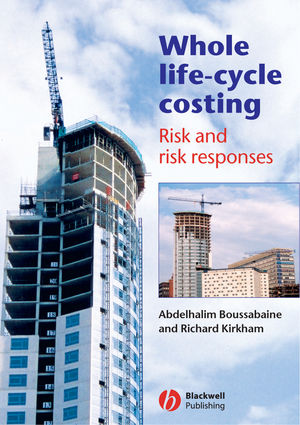Whole Life-Cycle Costing: Risk and Risk ResponsesISBN: 978-1-4051-0786-0
Hardcover
264 pages
December 2003, Wiley-Blackwell
 This is a Print-on-Demand title. It will be printed specifically to fill your order. Please allow an additional 10-15 days delivery time. The book is not returnable.
|
||||||
Preface xi
Acknowledgements xiii
Part I: Fundamentals of Whole Life-cycle Costing
1 Towards an Understanding of Whole Life-cycle Costing 3
1.1 Introduction 3
1.2 Whole life-cycle costing: a brief history 4
1.3 Defining whole life-cycle costing 7
1.4 Risk and uncertainty in WLCC 9
1.5 Subjectivity in WLCC 9
1.6 Summary 10
References 10
2 Whole Life-cycle Costing Risk Management 12
2.1 Introduction 12
2.2 Why has the construction industry failed to embrace WLCC? 12
2.3 Why risk assessment in whole life costing? 13
2.4 Data requirements in whole life-cycle costing and risk assessment 15
2.5 Specifying a comprehensive set of objectives and measures for each WLCC component 17
2.6 A framework for whole life costing risk management 22
2.7 Summary 26
References 26
3 Key Decisions in the Whole Life-cycle Costing Process 28
3.1 Introduction 28
3.2 Justification for investment and extraction of client requirements 29
3.3 Key decisions at the conceptual development stage 31
3.4 Key decisions at the detailed design stage 32
3.5 Key decisions at the production stage 33
3.6 Decisions at the operational stage 34
3.7 Decisions at the end of economic life stage 35
3.8 Summary 35
References 36
4 Fundamentals of Whole Life-cycle Cost Analysis 37
4.1 Introduction 37
4.2 Concepts of the time value of money 37
4.3 WLCC calculation models 38
4.4 Measuring economic performance in whole life-cycle costing 41
4.5 WLCC forecasting methods 49
4.6 Benchmarking and key performance indicators 52
4.7 WLCC key performance indicators 53
4.8 Summary 54
References 54
5 Whole Life Risk Analysis Techniques 56
5.1 Introduction 56
5.2 Risk analysis 56
5.3 Qualitative risk analysis 58
5.4 Risk matrices 58
5.5 Risk registers 60
5.6 Event trees 61
5.7 Influence diagrams 62
5.8 SWOT analysis 63
5.9 Brainstorming sessions 63
5.10 Quantitative risk analysis 64
5.11 Probabilistic approaches to risk 64
5.12 Simulation 71
5.13 Sensitivity analysis 74
5.14 Markov theory 74
5.15 Deterministic measures of risk 75
5.16 Mathematical and analytical techniques 77
5.17 Artificial intelligence and fuzzy set theory 78
5.18 Summary 81
References 82
Part II: Whole Life-cycle Costing: The Design Stage
6 Design Service Life Planning 87
6.1 Introduction 87
6.2 Estimation of service life for new structures 88
6.3 Estimation of the remaining service life for existing structures 95
6.4 Summary 103
References 104
7 Design Environmental Life-cycle Assessment 106
7.1 Introduction 106
7.2 Life-cycle assessment 107
7.3 Life-cycle assessment for design optimisation 110
7.4 LCA tools 112
7.5 Environmental life-cycle cost 114
7.6 Case study 117
7.7 Summary 120
Reference 121
8 Whole Life-cycle Cost Planning at the Design Stage 122
8.1 Introduction 122
8.2 Design whole life-cycle cost planning 122
8.3 An integrated framework for WLC budget estimation 123
8.4 Benchmarking WLC budgets 126
8.5 Whole life cost planning 128
8.6 Summary 141
References 141
9 Whole Life Risk and Risk Responses at Design Stage 142
9.1 Introduction 142
9.2 Design whole life risk 143
9.3 WLC risk identification and risk response measures at design/precontract stages 146
9.4 WLCC risk categorisation 154
9.5 Design WLCC risk quantification 154
9.6 Design risk response measures 159
9.7 Summary 161
References 162
10 Whole Life-cycle Costing of Mechanical and Electrical Services: a Case Study 163
10.1 Introduction 163
10.2 Modelling the whole life cost of air-conditioning systems 164
10.3 Data and methodology 166
10.4 Results and discussion 170
10.5 Summary 174
References 174
Part III: Whole Life-cycle Costing: Construction and Occupancy Stages
11 Whole Life Risk and Risk Responses at Construction Stage 179
11.1 Introduction 179
11.2 WLCC at the construction stage 179
11.3 WLCC risk during the construction stage 180
11.4 Typology of WLCC risk at the construction stage 180
11.5 Tools for allocating WLCC construction risk 187
11.6 Significance of WLCC risk at the construction stage 188
11.7 Monitoring WLCC risk throughout the construction programme 188
11.8 Construction WLCC risk responses 189
11.9 Summary 190
References 190
12 Whole Life Risk and Risk Responses at Operational Stage 191
12.1 Introduction 191
12.2 WLCC risks at operation stage 191
12.3 Identifying the WLCC operational risks 192
12.4 The maintenance cost centre 193
12.5 The energy cost centre 195
12.6 The facilities management cost centre 195
12.7 Identifying the operational stage WLCC drivers 199
12.8 Operational stage WLCC: risks and risk responses 199
12.9 Summary 204
References 204
13 Whole Life-cycle Costing during Operational Stage 205
13.1 Introduction 205
13.2 Operational stage WLCC models 206
13.3 The importance of operational costs in WLCC 206
13.4 Conceptualising the WLCC model 206
13.5 Existing WLCC models 207
13.6 Recording WLCC data during occupancy stage 208
13.7 Forecasting energy WLCC: a case study 210
13.8 New WLCC models for operational stage WLCC analysis 216
13.9 WLCC for an existing building: a case study of facilities management cost modelling 220
13.10 Summary 222
References 222
14 Whole Life Costing of Building Assets Occupancy: a Case Study 223
14.1 Introduction 223
14.2 Sources of occupancy costs 223
14.3 Set-up costs 225
14.4 Non-controllable occupancy costs 226
14.5 Controllable occupancy costs 226
14.6 Disruption costs 227
14.7 Data and methodology 229
14.8 Results and analysis 234
14.9 Summary 241
References 241
Index 243



